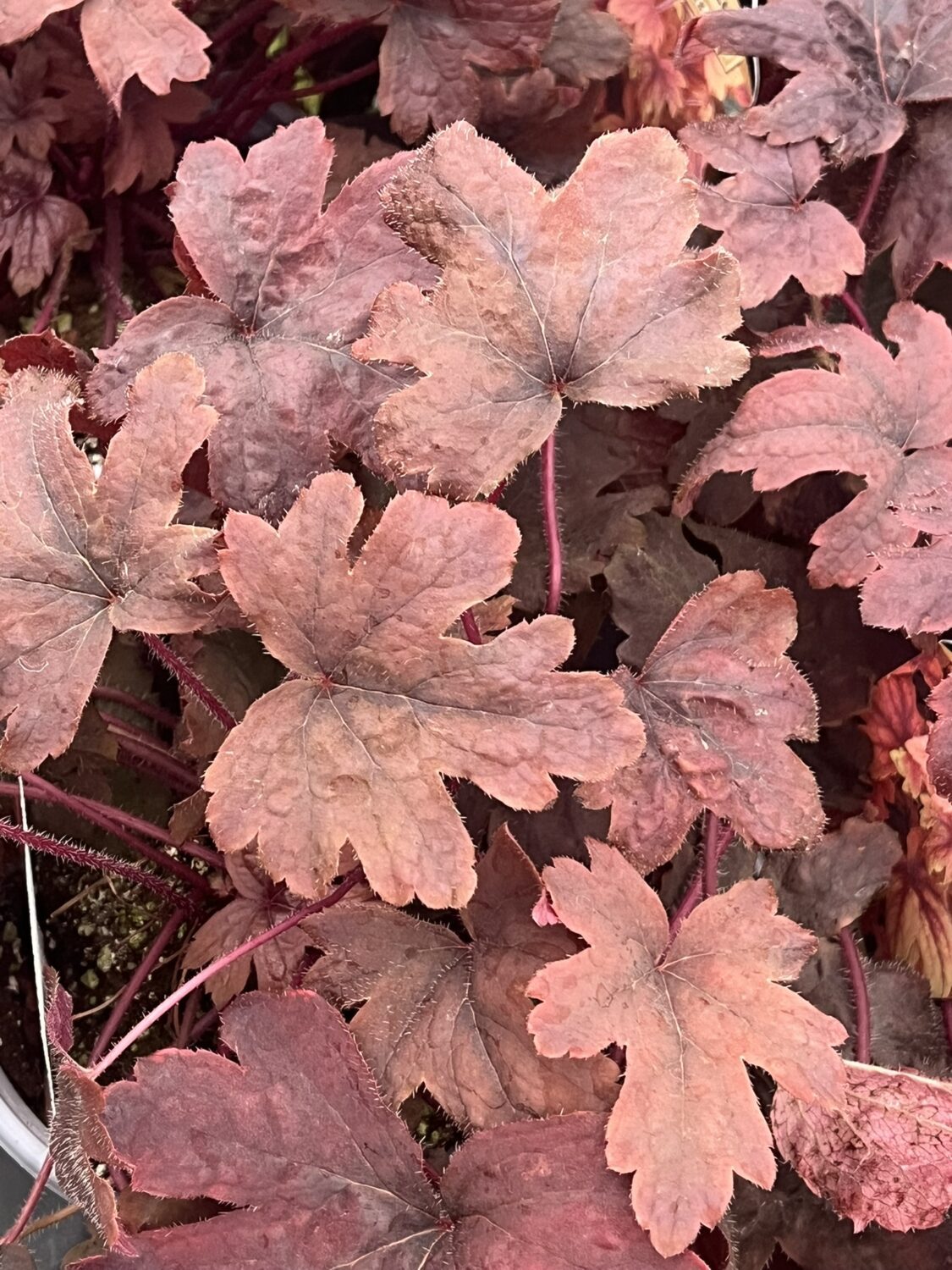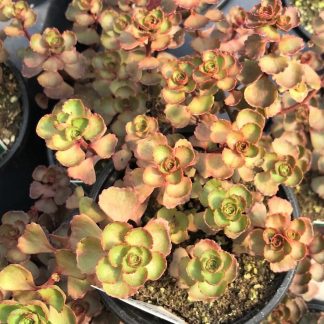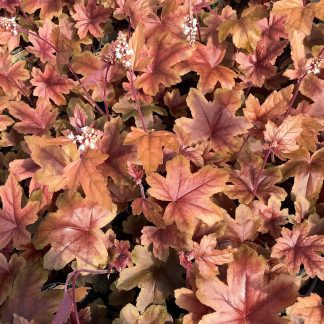Description
Savoring the Charm of Heucherella ‘Sweet Tea’
A garden is like a gathering of friends. Each plant brings its own flavor, mood, and melody. One plant, though, feels a bit like a refreshing sip of iced tea shared on a shady porch—welcome in every season and soothing to the spirit. Let’s settle in together and explore Heucherella ‘Sweet Tea,’ a foliage star that pours warmth and beauty into beds, borders, and containers.
Unpacking the Blend
Where Heucherella Comes From
Heucherella is a cross between Heuchera (coral bells) and Tiarella (foamflower). Think of it as the best of both parents—Heuchera’s bold colors plus Tiarella’s charming leaf shapes and spring blooms. ‘Sweet Tea’ is one of the most beloved of these hybrids, prized for its rich, cinnamon-tea leaves and easygoing nature.
Visual Snapshot
- Foliage: Oversized leaves start warm caramel in spring, deepen to burnt amber in summer, and soften to butterscotch when cool autumn air drifts in. A big, star-shaped mahogany pattern sits in the center, adding drama.
- Flowers: In late spring, delicate white wands rise above the leaves, bringing a foamy burst that pollinators love.
- Habit: Plants mound up to 20 inches tall and spread about 24 inches wide, making a generous clump without overrunning its neighbors.
- Zones: Hardy in USDA Zones 4 through 9, so most of us can enjoy it year after year.
- Style Match: Woodland gardens, cottage borders, patio pots, or mass plantings for a tapestry effect. It’s a standout in shade but can handle morning sun without fuss.
Why ‘Sweet Tea’ Wins Hearts
Color That Keeps Pouring
Many perennials strut their stuff for a brief moment, then fade. Not ‘Sweet Tea.’ Its foliage remains the main event from the first warm days of spring to the final frost’s kiss. Gardeners hungry for low-maintenance color adore this trait.
Texture That Plays Nice
Those big lobed leaves add bold texture beside ferns, hostas, and astilbes. The patterned center looks almost hand-painted, giving depth without the need for blooms. Pair it with finer foliage to create contrast that feels lively yet balanced.
A Welcoming Home for Wildlife
The airy blooms invite native bees and tiny butterflies. Even though flowers aren’t large, they add an ecological touch—turning your shade corners into mini pollinator cafés.
How to Grow and Care for Heucherella ‘Sweet Tea’
Growing ‘Sweet Tea’ is more about guiding than fussing. Follow these steps and the plant will repay you with season-long beauty.
1. Light
- Ideal: Dappled shade to bright morning sun with afternoon shade.
- Why: Too much harsh sun may scorch the leaves, while deep shade dulls the color. Aim for that “filter of tree leaves” effect.
- Tip: In northern zones, a half day of gentle sun deepens tones. In hotter southern climates, tuck plants where midday sun can’t reach.
2. Soil
- Texture: Loose, humus-rich, and well-drained. Heavy clay can cause root rot.
- pH: Slightly acidic to neutral is perfect.
- Boost: Work in compost or leaf mold to mimic woodland humus. This feeds the plant and improves drainage.
3. Water
- Establishment: Keep soil consistently moist the first growing season. Think damp sponge, not soggy towel.
- Mature Care: Once roots run deep, water when the top inch feels dry. Deep, infrequent drinks encourage resilient roots.
- Container Reminder: Pots dry out faster. In summer, check daily and water when needed.
4. Feeding
- Spring Snack: A light scattering of balanced, slow-release fertilizer or a top-up of compost in early spring gets leaves off to a good start.
- Less Is More: Too much nitrogen can soften stems and invite disease. A gentle hand fosters sturdy growth and richer color.
5. Mulching
- Purpose: Locks in moisture, blocks weeds, and cushions temperature swings.
- Material: Shredded bark, leaf litter, or fine pine needles.
- Depth: Two inches is plenty—keep mulch away from the crown to prevent rot.
6. Pruning and Grooming
- Spent Flowers: Snip fading flower wands to tidy the clump and redirect energy to foliage.
- Tired Leaves: Remove any ragged or overwintered leaves in early spring. Fresh growth quickly fills gaps.
- Division: Every three to four years, lift and divide clumps in early spring or early fall. This renews vigor and gives you more plants to share.
7. Winter Prep
- Zones 4–6: A light mulch after ground freezes protects crowns from freeze-thaw cycles.
- Zones 7–9: Plants usually overwinter with no extra help, but mulch still suppresses winter weeds.
- Evergreen Charm: In mild winters, foliage often stays colorful, offering winter interest when the garden feels bare.
8. Pests and Problems
| Issue | Clue | Rescue Plan |
|---|---|---|
| Root Rot | Leaves wilt, crown mushy | Improve drainage, water less frequently |
| Vine Weevils | Notched leaf edges | Apply beneficial nematodes in late summer |
| Rust or Mildew | Spots or powder on leaves | Space plants, ensure airflow, remove affected leaves |
| Sun Scorch | Bleached patches | Provide more shade, add mulch to stabilize moisture |
9. Companion Planting Ideas
- With Ferns: The feathery fronds accent the bold leaf shapes.
- With Hosta ‘Blue Angel’: Blue foliage sets off the warm caramel hues.
- With Brunnera ‘Jack Frost’: Silver-flecked leaves create a soft glow beside ‘Sweet Tea.’
- With Spring Bulbs: Plant snowdrops or mini daffodils between clumps; they bloom early, then ‘Sweet Tea’ hides the fading bulb foliage.
10. Container Craft
A single plant in a terracotta pot makes a charming table accent. For larger planters, try this recipe:
- Thriller: Upright Japanese forest grass (Hakonechloa) for movement.
- Filler: Our star, Heucherella ‘Sweet Tea,’ adding depth.
- Spiller: Creeping Jenny (Lysimachia nummularia ‘Aurea’) cascading over edges, echoing golden notes.
11. Propagation Pathways
- Division: The simplest route. Gently pry apart the crown, keeping at least three healthy growth points per division. Replant right away.
- Basal Cuttings: In spring, take firm shoots with a sliver of crown tissue. Root in moist potting mix under gentle light.
- Seed: Not recommended, as seedlings rarely match the parent’s striking color.
Seasons in the Cup—Year-Round Guide
| Season | What You’ll See | What You Should Do |
|---|---|---|
| Spring | New caramel leaves unfurl, flower stems rise | Remove old leaves, feed lightly, water as growth picks up |
| Summer | Color intensifies to rich amber; mound is full | Water during dry spells, trim any spent blooms |
| Autumn | Foliage softens to butterscotch and gold | Enjoy the show, clear fallen debris, divide if needed |
| Winter | Leaves may stay, adding russet tones | Mulch if in cold zone, resist heavy watering |
Troubleshooting at a Glance
- Leaves Pale or Greenish: Too much shade. Move to brighter spot with gentle sun.
- Foliage Browns at Edges: Heat stress or drought. Increase shade, water deeply.
- Plant Seems Stalled: Soil may be exhausted. Add compost or balanced fertilizer in spring.
- Center Dies Out: Time to divide. Fresh divisions rejuvenate growth.
Designing With ‘Sweet Tea’
- Woodland Layers: Under a canopy of dogwoods, blend ‘Sweet Tea’ with epimediums, hellebores, and bleeding hearts for a four-season understory.
- Pathway Edges: Line a shady walkway. The warm tones invite visitors forward like a trail of lanterns.
- Color Echo: Near copper garden accents or terracotta pots, the foliage appears brighter and more harmonious.
- Season Switch: Plant beside tulips ‘Princess Irene’ in spring and purple asters in fall to keep color bouncing around.
Kids, Pets, and Peace of Mind
‘Sweet Tea’ is non-toxic to people and pets. Its soft leaves tempt curious fingers, making it a friendly choice for family gardens. Still, teach youngsters to admire, not nibble, every plant.
Quick Q&A
- Can I grow it indoors? It prefers outdoor conditions. Indoors, light and humidity often fall short. A sheltered porch is better.
- Does it self-seed? Rarely. You won’t wake up to a carpet of seedlings.
- How fast does it spread? Moderate pace—enough to fill a gap, not enough to crowd neighbors.
- Will deer eat it? Heucherella foliage tastes bitter to most deer, so browsing is uncommon, though no plant is ever fully deer-proof.
Tasting Garden Joy, One Leaf at a Time
Heucherella ‘Sweet Tea’ invites us to slow down and savor the garden like a beloved beverage—comforting, flavorful, and best enjoyed together. When you tuck this plant into dappled shade, you bring home a hardy companion that offers color from early spring to late fall, asks for little, and returns year after year. Let its warm leaves welcome you each time you pass by, reminding us that beauty can be both simple and generous. Pour it into your landscape, and your garden will feel richer, sweeter, and deeply refreshed.




